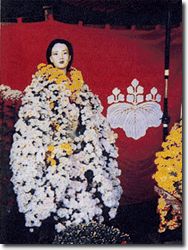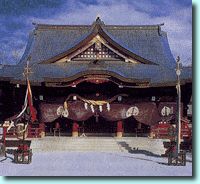|
|
 |
| | TRIP OUT TOP | |
 |
Access:
|
|
Kasama, a small town in Ibaraki-ken north of Tokyo, is famous for its Kasama-yaki ceramic ware, Kasama Inari Shrine and Inada granite. Not bad for a town with a population of 30,000. Kasama is also a flower-loving town. Besides the usual autumn blossoms, although azaleas look more than well-represented with a whole hill of the blooms, Inari Shrine also grows chrysanthemums, and more to the point, figures sculpted from the imperial flowers. At least the town doesn't try to compete with nearby Kairakuen Garden in Mito for plum blossoms. Kasama is one of those places you take an instant liking to the moment you get off the train because it is in the middle of nowhere and fields are all around. There is a bicycle rental place by the station but this turns out to be not such a good idea, because all directions seem to lead "up the hill." Kasama
Inari Shrine is, with Fushimi Inari Shrine in Kyoto (the shrine featured
in a Kabuki play Yoshitsune Senbonzakura) and Toyokawa Inari Shrine in
Aichi-ken, one of the three most popular Inari shrines in the country.
It was founded in 651 and is dedicated to Ukanomitama no Mikoto, a Shinto
deity. In the compounds there are many statues of a fox which is popularly
believed to be the messenger-animal of Inari, the goddess of rice. Don't
miss the wood carvings at the back of the shrine and two 400-year-old
wisteria trees designated important natural properties. The shrine's annual
festivals include Hatsu Mode (some 2 million people make the first pilgrimage
of the year), Setsubun on February 3, Reitaisai on April 9, and O-taue
Sai on May 28. |
It features Oishi Kuranosuke and other characters in the NHK drama Genroku
Ryoran broadcast on Sundays, which stars the Kabuki prince Nakamura Kankuro,
Natsuki Mari, Miyazawa Rie and others. The Kasama Nichido Bijutsukan is
located up the road from the Inari Shrine. It consists of two buildings,
a sculpture garden and the best carp pond we've seen in some time. Built
in 1972 by the late Hasegawa Jin, it houses some of its extensive collection
of art which includes Picasso, Foujita and Warhol. On the left side of the
exit of the museum is the Nichido Museum of Sport Cars. We headed up Mt.
Sanshiro to see the ruins of Kasama Castle built in 1219. The enemies must
have had a hard time getting there. But once up there, there is a great
view over the town and Mt. Fuji from yet another angle. For the Kasama-ware experience go to Fukuda Kiln by turning right once you exit Kasama Station -- get a map at the station. You'll eventually find it since the sign for the kiln is in hiragana, so that, as Mr. Fukuda says, "everybody can read it." In the compound there are four vases including one 5.4 meters high and another of 6.4 meters, which is the largest in the world. One Kasama-yaki vase was presented to Peru. From 9am-5pm you can try your hand at pottery-making. For ´1,000 you'll be given a piece of clay and for an additional ´200 they'll fire your "masterpiece." Happily, they speak English and of course if you don't expect your work to be that hot, you can purchase the real masterpieces. The Fukuda family has been operating the kiln for 200 years. At Geijutsu no Mura (Art Village) you can find Shunpu Banri-so, the former residence of Ryozanjin, a cook frustrated by the lack of good dishes who made his own "plates and saucers" for his specialties. It is a beautiful house with a tearoom, scrolls, a hibachi and other goodies. There is a large garden and a stone garden. The stone garden may not be as famous as Kyoto's Ryoanji, but still provides the opposite experience to rush hour at Shinjuku. Always a good reason to go. |
| | TRIP OUT TOP | |
© MERIT 5 Co., Ltd.